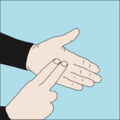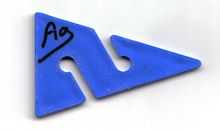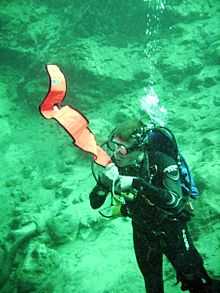Diver communications
_Rick_West_and_divers_from_Southwest_Regional_Maintenance_Center_conduct_pre-dive_checks.jpg)
Diver communications are the methods used by divers to communicate with each other or with surface members of the dive team.
There are several distinct forms of diver communications:
- Voice communications – Most professional diving equipment such as full face diving masks and diving helmets include voice communication equipment
- Video communications – Surface supplied divers often carry a closed circuit video camera on the helmet which allows the surface team to see what the diver is doing and to be involved in inspection tasks. This can be used to transfer signals to the surface if voice comms fails, and is in itself a one way mode of communicating useful data to the surface.
- Text communications – Underwater slates may be used to write text messages which can be shown to other divers,[1] and there are some dive computers which allow a limited number of pre-programmed text messages to be sent through water to other divers or surface personnel with compatible equipment.[2]
- Non-verbal communications:
- Hand signals – Recreational divers do not usually have access to voice communication equipment, and it does not generally work with a standard scuba demand valve, so they use other signals. Hand signals are generally used when visibility allows, and there are a range of commonly used signals, with some variations. These signals are often also used as an alternative by professional divers
- Line signals (rope pulls) – Rope signals can be used if the diver is connected to another diver or tender by a rope or umbilical. There are a few partly standardised codes using "pulls" and "bells" (a pair of short tugs). These are mostly used as backup signals by professional divers in the event that voice communications fails, but can be useful to recreational and particularly technical divers, who can use them on their surface marker buoy lines to signal to the surface support crew.
- Light signals – Made using an underwater torch at night. There are not many standard light signals. Suitably skilled divers can transmit morse code using a light.
- Cave line symbols – these are symbols attached to cave lines, indicating critical information such as the direction to the exit.
- Sign language Divers who are familiar with a sign language such as American sign language and equivalents may find it useful underwater, but there are limitations due to the difficulty of performing some of the gestures intelligibly underwater with gloved hands and often while trying to hold something.
- Tap codes – made by knocking on the walls, are used occasionally to communicate with divers trapped in a sealed bell or the occupants of a submersible during a rescue.
- Rattle – a tube containing ball bearings used by guides of large groups to attract attention.
- Miscellaneous emergency signals – Including the use of mirrors, compressed air sirens, whistles, noisemakers, colour-coded Delayed Surface Marker Buoys etc., to alert the surface support personnel of a problem
- Diver down signals – The dive flags, lights and shape signals used to indicate the presence of divers in the water.
Voice communications
Both hard-wired (cable) and through-water electronic voice communications systems may be used with surface supplied diving. Wired systems are more popular as there is a physical connection to the diver for gas supply in any case, and adding a cable does not make the system any different to handle. Wired communications systems are still more reliable and simpler to maintain than through-water systems. The communications equipment is relatively straightforward and may be of the two-wire or four-wire type. Two wire systems use the same wires for surface to diver and diver to surface messages, whereas four wire systems allow the diver's messages and the surface operator's messages to use separate wire pairs.
A standard arrangement with wired diver communications is to have the diver's side normally on, so that the surface team can hear anything from the diver at all times except when the surface is sending a message. This is considered an important safety feature, as the surface team can monitor the diver's breathing sounds, which can give early warning of problems developing, and confirms that the diver is alive.
Divers breathing helium may need a decoder system which reduces the frequency of the sound to make it more intelligible.
Through water communications systems are more suitable for scuba as the diver is not encumbered by a communications cable, but they can be fitted to surface supplied equipment if desired. Most through water systems have a Push To Talk (PTT) system, so that high power is only used to transmit the signal when the diver has something to say. For commercial diving applications this is a disadvantage, in that the supervisor can not monitor the condition of the divers by hearing them breathe.
Dry bells may have a through water communication system fitted as a backup.[3]
Voice communication protocol
Underwater voice communication protocol is like radio communication protocol. The parties take turns to speak, use clear, short sentences, and indicate when they have finished, and whether a response is expected. Like radio, this is done to ensure that the message has a fair chance of being understood, and the speaker is not interrupted. When more than one recipient is possible, the caller will also identify the desired recipient by a call up message, and will also usually identify him/herself.
The surface caller should also give the diver a chance to temporarily suspend or slow down breathing, as breathing noise is often so loud that the message can not be heard over it.
-

A hard-wired diver communications unit mounted in a waterproof box for convenience of transport and protection. The loose speaker has been added to increase output volume. there is a built in speaker behind the perforations on the panel
-

Inside a Kirby Morgan 37 helmet showing the microphone in the oro-nasal mask, and one of the speakers at the top of the photo
Hand signals

Hand signals are a form of sign system used by scuba divers to communicate when underwater.
The Recreational Scuba Training Council agencies have defined a set of hand signals intended for universal use, which are taught to diving students early in their entry level diving courses.[4] The more commonly used hand signals provide the following information:
In most situations simple hand signals are used. The RSTC signals include:
- I am out of breath! Hands indicate rising and falling chest.[5][6]
- Go that way: Fist with one hand, thumb extended and pointing in the direction indicated.
- Go under, over or around: With palm down, hand motion used to indicate intended route to go under, over or around an obstacle.
-

Ascend, or I am going up: A fist is made with one hand, thumb extended upward, and hand is moved upward to emphasize direction of travel.
-

Descend, or I am going down: A fist is made with one hand, thumb extended downward, and hand is moved downward to emphasize direction of travel.
-

Something is wrong: An open hand with palm down and fingers apart is rocked back and forth on the axis of the forearm.
-

Are you OK? or I am OK! A circle is made with thumb and forefinger, extending the remaining fingers if possible.
-

The OK sign may be also be made without extending the fingers if wearing gloves
-

I'm OK: Forming a large circle with both hands above the head: Used at the surface as the OK hand sign can be difficult to see from a distance.
-

I'm OK: Touching or tapping the top of the head with elbow extended sideways: Used at a distance when the hand sign may be difficult to see. Alternative surface "OK" signal.
-

Stop! Hand raised vertically with fingers together and palm facing the receiver.
-

Turn around: A forefinger extended vertically and rotated in a circular motion.
-

Which direction? A fist is make with one hand with extended thumb and the hand rotated on the axis of the forearm through 180° a few times to ask which way to go.
-

Boat: Hands cupped together.
-

Buddy reference. Used alone: Get with your buddy: Fists made with both hands, forefingers extended, and hands placed together with forefingers parallel and in contact.
-

Hold on to each other - Maintain physical contact: Both hands clasped together.
-

Who will lead, who will follow: One hand pointed at the diver who will lead then positioned in front of the body, pointing forward, then other hand pointed to the diver who will follow and positioned behind the first, direction indicated with forefingers.
-

Level off at this depth: Flat hand with palm down and fingers spread moved slowly side to side horizontally a few times.
-

Take it easy, Relax or Slow down: Flat hand with palm down moved slowly up and down a few times.
-

Give me air now (emergency implied): pointing to the mouth with thumb and fingers together, moving hand back and forth a short distance.
-

Emergency! Help me now: Waving one or both arms in a wide arc. Used on the surface.
-

I don't know: Shrugging shoulders, arms bent, hands to each side, palms up
-

Danger in that direction: Clenched fist pushed/pointed in the direction of the perceived hazard
-

I am cold: Hugging chest and crossed arms in front of chest, upper arms grabbed by opposite hands.
-

Look: Point with two fingers to the eyes.
-

Think. or remember: Forefinger extended from fist, touching the side of the head at the temple.
-

I can't clear this ear: Pointing at the ear with forefinger.
- ^ "Dive Links". Retrieved 2009-04-14.
- ^ "Underwater Signals - UKDivers.net". Retrieved 2009-04-14.
Other commonly used hand signals and variations
Diving signals sometimes differ between groups of divers. Some variations include:
- The throat cut signal: "general danger" or "emergency".
- Tapping the mouthpiece: "share air".
- Pointing at the ear: "listen!"
- Hand cupped behind ear: "listen!"
- Pointing at someone changes the reference of the next signal from "I" to the diver pointed at.
- Pointing at side of head with screwing movement: "I am dizzy"; or "there is a boat moving about" (the screwing represents a propeller).
- Index finger pointed up/down: "let's go up/down".
- Thumb up: "I am OK" (often with naval divers)
- Flat hand swept over top of head, palm down: "I have a ceiling". This can indicate the diver has gone into decompression obligation or that there is a solid obstruction overhead. When ascending it means "stop here". (this is my decompression ceiling, or we are ascending too fast, or just generally stop ascending at this depth).
- Moving hand across torso in wave motion: "Current"
-

How much air do you have left?: One hand held flat, palm up, while index and middle finger of the other hand are placed on the palm.
-

There is air leaking from your equipment: Index finger is brought down to thumb in repetitive motion. Size of movement indicates severity of leak.
-

Cut the line: A request to another diver to cut a line or net. Often used in case of entanglement where the diver making the signal can not reach the point where the line should be cut.
-

Safety stop: Signal is used to indicate that the diver intends to do a safety stop at that point.
-

Line, Line tangle or Cutting the line: The index finger is crossed with the middle finger to indicate line. If the hand is moved in a figure 8 it means a line tangle. Pointed down and rotated means a line tie off. In combination with the cutting signal it means cut the line.
-

Silt, or Silting: Palm and fingers down, thumb rubbed against the tips of the fingers
-

I have a cramp: Repeatedly clenching and unclenching fist, and point at cramped area
-

I am on reserve or I am on bailout gas or I am low on gas: Clenched fist held steady, about level with head or chest, palm side usually forward.
-

Time up - time to turn the dive and start heading back: Flat hand held roughly horizontal with tips of other flat hand's fingers touching the palm at right angles. Can also signify half of starting air remaining (in response to the "Pressure" signal).
-

Come and get me as soon as you can, but not an emergency: Signal to boat. Arm held straight up at the surface
-

Turn or terminate the dive. The thumb points upwards to indicate ascent, and the forefinger points towards the exit from a penetration dive
-

I am stuck: Thumb clenched between forefinger and middle finger of fist.
-

Ascend to stop: Thumb-up ascent signal below a flat hand, palm down.
Divers sometimes invent local signals for local situations, often to point out local wildlife. For example:
- I see a hammerhead shark: Both fists against sides of head[6]
- I see a lobster: Fist with index and middle finger pointed out horizontally and alternately waggling up and down[6]
- I see an octopus: Back of hand or wrist covering mouth, all fingers pointing outward from mouth and wiggling
- I see a shark: Hand flat, fingers vertical, thumb against forehead or chest[6]
- I see a turtle: Hands flat one on top of each other, palms down, waving thumbs up and down together[6]
Instructor signals:
- You (all) watch me. (usually before demonstrating a skill): Point at diver(s) with forefinger, point at own eyes with forefinger and middle finger, point at own chest with forefinger.
- You try that now, or do it again: Gesture with open hand palm up towards student after a demonstration of a skill.
Torch / flashlight signals
The focused beam of a torch can be used for basic signalling as well.
- OK signal: Drawing a circle on the ground in front of buddy.
- Attention please! Waving the torch up/down.
- emergency! Rapid horizontal motion
Normally a diver does not shine a torch / flashlight in another diver's eyes but directs the beam to his or her own hand signal.
-

Light signal OK
-

Light signal Attention
-

light used to illuminate hand signal
Rope signals
These are generally used in conditions of low visibility where a diver is connected to another person, either another diver or a tender on the surface, by a rope. These date back to the time of the use of Standard diving dress. Some of these signals, or pre-arranged variants, can be used with a surface marker buoy. The diver pulls down on the buoy line to make the buoy bob in an equivalent pattern to the rope signal.
The British Sub-Aqua Club rope signals are
- 1 pull – are you OK? reply 1 pull – Yes I am OK
- 2 pulls – Stay put reply 2 pulls – I am stationary
- 3 pulls – Go down reply 3 pulls – I am going down
- 4 pulls – Come up reply 4 pulls – I am coming up
- 5 or more pulls – Emergency: bringing you to the surface or Emergency: bring me to the surface (no reply required)
Public Safety Divers
Public safety divers and many recreational divers use the following line signals while conducting circular and arc searches underwater.
Tender to diver
- One pull on the line: okay, okay?
- Two pulls: stop, take out slack, reverse direction
- Three pulls: come to the surface
- Four pulls: stop, don't move (there could be danger ahead or a boat entering the search area)
Diver to tender
- One pull on the line: okay, okay?
- Two pulls: advance line
- Three pulls: object found
- Four or more pulls: assistance needed
Commercial diving rope signals
Rope signals used in the UK[7] and South Africa include the following:
Signals are combinations of pulls and bells, A pull is a relatively long steady tension on the line. Bells are always given in pairs, or pairs followed by the remaining odd bell. They are short tugs, and a pair is separated by a short interval, with a longer interval to the next pair or the single bell. The technique and nomenclature derive from the customary sounding of the ships bell every half hour during the watches, which is also performed in pairs, with the odd bell last. One bell is not used as a diving signal as it is difficult to distinguish it from a jerk caused by temporarily snagging the line.
Attendant to diver:
General signals:
- 1 pull – Calling for attention, are you OK
- 2 pulls – I am sending down a rope's end (or other pre-arranged item)
- 3 pulls – You have come up too far, go back down till we stop you
- 4 pulls – Come up
- 4 pulls and 2 bells – Come to the surface immediately (often for surface decompression)
- 4 pulls and 5 bells – Come up your safety float line
Direction signals:
- 1 pull – Search where you are
- 2 bells – Go out along the jackstay or distance line, or straight out away from tender
- 3 bells – Facing shot or tender, go right
- 4 bells – Facing shot or tender, go left
- 5 bells – Come back towards shot or tender, or back along jackstay.
Diver to attendant:
General signals:
- 1 pull – To call attention, or have completed the last instruction.
- 2 pulls – Send down a rope's end or other pre-arranged item
- 3 pulls – I am going down
- 4 pulls – I wish to come up
- 4 pulls and 2 bells – Help me up
- 5 or more pulls – Emergency, pull me up immediately
- succession of 2 bells – I am fouled and need standby diver to assist
- succession of 3 bells – I am fouled but can get clear without assistance
- 4 pulls and 4 bells – I am trying to communicate on voice comms
Working signals:
- 1 pull – Hold on or stop
- 2 bells – Pull up
- 3 bells – lower
- 4 bells – Takeup slack on the lifeline or lifeline is too tight
- 5 bells – I have found, started or completed the work
Cave line symbols

Cave arrows, Line arrows or Dorff markers (after Lewis Holtzendorff). These are plastic arrowhead markers which are hooked onto a cave line by wrapping the line around the arrow through the slots. They are used to indicate the direction to the exit, and can be identified by feel. The message is simple, but of critical importance, as if a diver does not know which way to go at a line junction there is a risk of serious trouble. Line arrows are used at a junction on the permanent line, so when the diver gets back to the tie-off, he or she can identify which way to turn.
Miscellaneous emergency signals
A diver who has deployed a Delayed Surface Marker Buoy (DSMB) at the end of a dive may use a pre-arranged colour code to indicate if there is a problem. In some circles a yellow DSMB is considered an emergency signal, and red means OK. In most circles a second DSMB deployed on the same line will indicate a problem. A DSMB can also be used to carry up a slate with a message, but this is unlikely to be noticed unless a special arrangement has been made.
Diver down signals
Flags
- International code flag "Alpha" (White hoist, blue swallowtail fly)
- Diver down flag (Red with white diagonal)
Light and shape signals
A vessel restricted in her ability to manoeuvre, except a vessel engaged in mine-clearance operations, shall exhibit:
- three all-round lights in a vertical line where they can best be seen. The highest and lowest of these lights shall be red and the middle light shall be white;
- three Day shapes in a vertical line where they can best be seen. The highest and lowest of these shapes shall be balls and the middle one a diamond;
- when making way through the water, a masthead light or lights, sidelights and a sternlight, in addition to the lights prescribed in sub-paragraph 1;
- when at anchor, in addition to the lights or shapes prescribed in sub-paragraphs 1 and 2, the light, lights or shape prescribed in Rule 30.
A vessel engaged in dredging or underwater operations, when restricted in her ability to manoeuvre, shall exhibit the lights and shapes prescribed in sub-paragraphs (1, 2 and 3 above) of this Rule and shall in addition, when an obstruction exists, exhibit:
- two all-round red lights or two balls in a vertical line to indicate the side on which the obstruction exists;
- two all-round green lights or two diamonds in a vertical line to indicate the side on which another vessel may pass;
- when at anchor, the lights or shapes prescribed in this paragraph instead of the lights or shape prescribed in Rule 30.
Whenever the size of a vessel engaged in diving operations makes it impracticable to exhibit all lights and shapes prescribed in paragraph (above) of this Rule, the following shall be exhibited:
- three all-round lights in a vertical line where they can best be seen. The highest and lowest of these lights shall be red and the middle light shall be white;
- a rigid replica of the International Code flag "A" not less than 1 metre (3.3 ft) in height. Measures shall be taken to ensure its all-round visibility.
-

International code flag "Alpha"
-

U.S. Diver flag
-

Light signals for a vessel undertaking underwater operations at night. The red lights indicate the obstructed side, green lights indicate clear side.
-

Shape signals for a vessel undertaking underwater operations during daylight. The balls indicate the obstructed side, diamonds indicate clear side.
Surface marker buoys
Permanently buoyant or inflatable surface marker buoys may be used to identify and/or mark the presence of a diver below. These may be moored, as a shotline, and indicate the general area with divers, or tethered to one of the divers by a line, indicating the location of the group to people at the surface. This type of buoy is usually brightly coloured for visibility, and may be fitted with one of the diving flag signals.
A surface marker buoy (SMB) tethered to a diver is usually towed on a thin line attached to a reel, spool or other device which allows the diver to control the line length, so that excessive slack line can be avoided.
A deployable, or delayed surface marker buoy (DSMB) is an inflatable marker which the diver inflates while underwater and sends up at the end of a line to indicate position, and usually either that he or she is ascending, or that there is a problem. The use of a DSMB is common when divers expect to do decompression stops away from a fixed reference, or will be surfacing in an area with boat traffic, or need to indicate their position to the dive boat or surface team.
A group of moored surface marker buoys may be used to demarcate an area in which diving is taking place. This is more likely to be used by commercial, scientific or public service divers to cordon off a work or search area, or an accident or crime scene.
-

Inflatable surface marker buoy marked with diving flag
-
Delayed surface marker buoy with diver at the surface
-

A diver preparing to inflate a delayed surface marker buoy
References
- ↑ Agnew, J. (2003): Scuba Diver's Travel Companion, The Globe Pequot Press, Guilford, CT, ISBN 0-7627-2668-7
- ↑ "UDI Dive Computer Can Send Underwater Text Messages". Retrieved 2013-08-27
- ↑ The Diving Supervisor’s Manual, First edition, 2000. The International Marine Contractors Association, London. www.imca-int.com ISBN 1-903513-00-6
- ↑ Recreational Scuba Training Council, (2005), Common Hand Signals for Recreational Scuba Diving, Recreational Scuba Training Council, Inc, Jacksonville, FL. http://www.angelfire.com/nj4/divers/CommonHandSignalsforScubaDiving.pdf
- ↑
- ↑ 6.0 6.1 6.2 6.3 6.4
- ↑ Larn, R and Whistler, R. (1993): Commercial Diving Manual, David & Charles, Newton Abbott, ISBN 0-7153-0100-4
| Wikimedia Commons has media related to Diving signals. |


